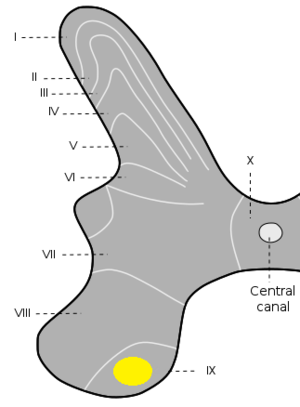Onuf's nucleus: Difference between revisions
No edit summary |
Kim Jackson (talk | contribs) m (Text replacement - "incontinence" to "Urinary Incontinence") |
||
| (35 intermediate revisions by 2 users not shown) | |||
| Line 1: | Line 1: | ||
== | <div class="editorbox"> '''Original Editor '''- [[User:Arnold Fredrick D'Souza|Arnold Fredrick D'Souza]] '''Top Contributors''' - {{Special:Contributors/{{FULLPAGENAME}}}}</div> | ||
Onuf's nucleus is a small group of motor neurons located in the anterior horn of the S2 segment of the spinal cord | == Introduction == | ||
[[File:Onuf's nucleus.png|thumb|Onuf's nucleus in lamina IX]] | |||
Onuf's nucleus is a small group of motor neurons located in the anterior horn of the S2 segment of the spinal cord. It is named after Bronislaw Onufrowicz, a neurologist, who first discovered the structure in 1899. It is the site of origin of the pudendal nerve.<ref name=":2">Watson C, Paxinos G, Kayalioglu G. The Organization of the Spinal Cord. In: Watson C, Kayalioglu G, editors.The Spinal Cord: A Christopher and Dana Reeve Foundation Text and Atlas. London: Academic Press, 2008. p5.</ref><ref name=":0">Mannen T. Neuropathology of Onuf's nucleus. Rinsho Shinkeigaku 1991; 31(Suppl 12):1281-5.</ref> | |||
== Functions == | == Functions == | ||
Through the pudendal nerve, Onuf's nucleus innervates the external anal and urethral sphincters, as well as two perineal muscles: ischiocavernosus and bulbospongiosus. Hence, it maintains bowel and bladder continence through the voluntary control of both external sphincters and enables sexual functions like penile erection and ejaculation through perineal muscle contractions.<ref name=":2" /><ref name=":0" /><ref name=":1">Mannen T. Neuropathological findings of Onuf's nucleus and its significance. Neuropathology 2000; 20:30-3.</ref> | |||
== Significance == | In addition to its motor functions, Onuf's nucleus also performs autonomic functions by association with parasympathetic neurons in the sacral segment of the spinal cord.<ref name=":1" /> | ||
== Clinical Significance == | |||
Onuf's nucleus, interestingly, is the only motor neuron preserved in [[Amyotrophic Lateral Sclerosis |Amyotrophic Lateral Sclerosis]].<ref name=":3">Mannen T, Iwata M, Toyokura Y, Nagashima K. Preservation of a certain motoneurone group of the sacral cord in amyotrophic lateral sclerosis: its clinical significance. J Neurol Neurosurg Psychiatry 1977; 40:464–469.</ref> Additionally, it is also spared in [[Spinal Muscular Atrophy (SMA)|Spinal Muscular Atrophy]], [[Duchenne Muscular Dystrophy]], and Poliomyelitis. In stark contrast, it is one of the most affected structures in [[Multiple System Atrophy]].<ref name=":0" /><ref name=":1" /> | |||
Therefore, the presence or absence of [[Urinary Incontinence]] and/or impotence allows clinicians to rule in or out the conditions mentioned above, from their differential diagnosis, subsequently saving time during a clinical examination. | |||
== References == | |||
<references /> | |||
Latest revision as of 10:55, 24 May 2022
Introduction[edit | edit source]
Onuf's nucleus is a small group of motor neurons located in the anterior horn of the S2 segment of the spinal cord. It is named after Bronislaw Onufrowicz, a neurologist, who first discovered the structure in 1899. It is the site of origin of the pudendal nerve.[1][2]
Functions[edit | edit source]
Through the pudendal nerve, Onuf's nucleus innervates the external anal and urethral sphincters, as well as two perineal muscles: ischiocavernosus and bulbospongiosus. Hence, it maintains bowel and bladder continence through the voluntary control of both external sphincters and enables sexual functions like penile erection and ejaculation through perineal muscle contractions.[1][2][3]
In addition to its motor functions, Onuf's nucleus also performs autonomic functions by association with parasympathetic neurons in the sacral segment of the spinal cord.[3]
Clinical Significance[edit | edit source]
Onuf's nucleus, interestingly, is the only motor neuron preserved in Amyotrophic Lateral Sclerosis.[4] Additionally, it is also spared in Spinal Muscular Atrophy, Duchenne Muscular Dystrophy, and Poliomyelitis. In stark contrast, it is one of the most affected structures in Multiple System Atrophy.[2][3]
Therefore, the presence or absence of Urinary Incontinence and/or impotence allows clinicians to rule in or out the conditions mentioned above, from their differential diagnosis, subsequently saving time during a clinical examination.
References[edit | edit source]
- ↑ 1.0 1.1 Watson C, Paxinos G, Kayalioglu G. The Organization of the Spinal Cord. In: Watson C, Kayalioglu G, editors.The Spinal Cord: A Christopher and Dana Reeve Foundation Text and Atlas. London: Academic Press, 2008. p5.
- ↑ 2.0 2.1 2.2 Mannen T. Neuropathology of Onuf's nucleus. Rinsho Shinkeigaku 1991; 31(Suppl 12):1281-5.
- ↑ 3.0 3.1 3.2 Mannen T. Neuropathological findings of Onuf's nucleus and its significance. Neuropathology 2000; 20:30-3.
- ↑ Mannen T, Iwata M, Toyokura Y, Nagashima K. Preservation of a certain motoneurone group of the sacral cord in amyotrophic lateral sclerosis: its clinical significance. J Neurol Neurosurg Psychiatry 1977; 40:464–469.







